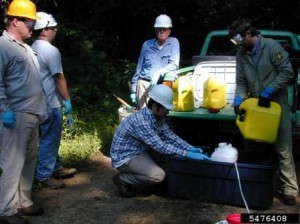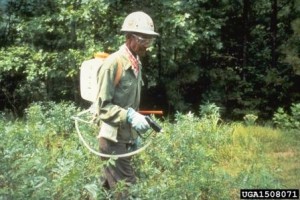|
|
Glyphosate
Active Ingredient (a.i.): N-(phosphonomethyl)glycine, as the isopropylamine salt
Brand-name Products (All product labels contain signal word of CAUTION):
- Roundup Ready-to-Use Spray 0.96% a.i.
- Roundup Concentrate 18% a.i.
- Roundup Super Concentrate 41% a.i.
- Roundup Pro, Roundup Ultra 41% a.i.
- accord, Glyfos 41% a.i.
- Rodeo 53.8% a.i.
Glyphosate is a broad-spectrum herbicide that is absorbed by plant leaves and is systemic (translocated) within the plant. Nearly all herbaceous plants and most woody plants are susceptible to glyphosate, which inhibits synthesis of three amino acids necessary for plant growth. Glyphosate is a rather slow-acting herbicide; symptoms appearing within a week include chlorosis (yellowing) and stunting of the youngest leaves and growing point. It may take more than 2 weeks for the plant to die. Injury symptoms and death occur more rapidly in young, actively growing plants and when temperatures are warm. Woody plants are more susceptible to glyphosate when treated in late summer or fall. Damage may not be apparent until the following spring as leaves either fail to emerge from buds or are dwarfed, misshapen, and yellow.
Glyphosate does not exhibit herbicidal activity in the soil. It is bound rapidly and tightly to soil particles (organic matter and clay), and therefore is not taken up by plant roots and does not affect seed germination. Although it is not absorbed by roots or through intact bark, it can cause damage if sprayed on exposed roots, or on bark that is very thin, green or cracked. Glyphosate is readily biodegraded by microorganisms, thus it does not persist in soil or water. When used properly, glyphosate poses minimal risk to human health or to the environment.
Both ROUNDUP PRO and ROUNDUP ULTRA contain a surfactant that enhances glyphosate absorption into treated leaves. If using a glyphosate formulation other than these two, addition of a non-ionic surfactant (0.5 fl. oz. per gallon) to the spray tank will increase the herbicidal activity of glyphosate.
For control of emergent or floating aquatic plants or plants growing along a shoreline (where spray will contact the water), the RODEO formulation of glyphosate should be used. RODEO does not contain surfactants included in ROUNDUP products. Prior to applying any pesticide to a body of water or to plants in a wetland, one must obtain a permit from DEP. The half-life of glyphosate in water is approximately 2 weeks, but it does not significantly affect submerged plants. Glyphosate toxicity to fish and other aquatic organisms is very low.
Triclopyr

Brand-name Products:
Active Ingredient (a.i.): 3,5,6-trichloro-2-pyridinyloxyacetic acid, as the triethylamine salt
- Brush-B-Gon Poison Ivy, Poison Oak & Brush Killer2 (Ready-to-Use Spray) 0.7% a.i.
- Brush-B-Gon Poison Ivy, Poison Oak & Brush Killer1 (Concentrate) 8.0% a.i. (Both have signal word: CAUTION)
- Garlon 3A 44.4% a.i. (Signal word: DANGER)
- Active Ingredient (a.i.): 3,5,6-trichloro-2-pyridinyloxyacetic acid, butoxyethyl ester
- Pathfinder II 13.6% a.i. (Signal word: CAUTION)
- Garlon 4 61.6% a.i. (Signal word: CAUTION)
- Crossbow: 2,4-D + Triclopyr (low volatile ester formulation) (Signal word: CAUTION)
Active Ingredients:
- 2,4-dichlorophenoxyacetic acid, butoxyethyl ester: 34.4%
- 3,5,6-trichloro-2-pyridinyloxyacetic acid, butoxyethyl ester: 16.5%
CROSSBOW is registered for use in pastures.
Triclopyr is a systemic herbicide that controls most broadleaf plants (herbaceous and woody) but not grasses or sedges at normal use rates. It is especially useful in brush control and for use on freshly cut stumps to prevent re-sprouting.
Triclopyr interferes with normal expansion and division of plant cells, resulting in distorted growth (cupped leaves, twisted stems, plugged vascular tissues). The herbicidal activity of triclopyr is more rapid than that of glyphosate. Herbaceous plants sprayed with triclopyr may show injury symptoms within 24 hours and usually die in a few days. Triclopyr is most effective when applied to actively growing plants. Woody plants treated late in the growing season are susceptible, but may not show injury symptoms until the following spring when leaves and stems fail to emerge or are greatly distorted.
Triclopyr is not strongly bound by soil particles, thus it could potentially leach into groundwater or run off into surface waters. However, it has rarely been detected in groundwater monitoring surveys. Triclopyr has residual herbicidal activity in soils (half-life approximately 6 weeks). Desirable plants can be injured by spray drift, or if their roots are exposed to triclopyr in the soil. Triclopyr has low to moderate toxicity to humans and wildlife.
Addition of a non-ionic surfactant [0.5 fl. oz. per gallon] to the spray tank will enhance herbicidal activity of triclopyr. Before applying CROSSBOW in a pasture, read the label restrictions on the number of days required before allowing animals to graze or hay to be harvested in treated areas.
Triclopyr has herbicidal activity on aquatic vegetation, but a formulation for aquatic weed control in development has not yet been approved by EPA.
Which of these herbicides is appropriate to use for a given situation?
The following list highlights some of the specific advantages of glyphosate and triclopyr:
GLYPHOSATE:
1) Controls invasive grasses such as Phragmites.
2) No soil activity - will not injure desirable plants via root uptake, rapidly deactivated and biodegraded in soil.
3) Very low health and environmental risks.
TRICLOPYR:
1) Does not kill grasses or sedges, thus unlikely to result in bare ground situation.
2) More effective than glyphosate on some woody species (eg. Oriental bittersweet, black locust).
3) Often provides better early-season control of perennial weeds.
CHEMICAL CONTROL STRATEGIES FOR INVASIVE PLANTS

The following products are readily available to homeowners and other property owners. Herbicide dosages (rates) mentioned in this guide refer to the product formulations listed below:
For GLYPHOSATE:
ROUNDUP Super Concentrate, ROUNDUP PRO, ROUNDUP ULTRA (41% active ingredient)
For TRICLOPYR:
ORTHO BRUSH-B-GON Poison Ivy, Poison Oak & Brush Killer1 (8% active ingredient)
Other Herbicides:
Glufosinate-ammonium: FINALE (11.33% active ingredient)
Potassium Salts of Fatty Acids: SAFER Superfast Weed & Grass Killer
Use the following volume measurements when mixing herbicide solutions:
2 tablespoons (Tbsp.) = 1 fluid ounce (fl. oz.) = 30 milliliters
8 Tbsp. = ½ cup = 4 fl. oz.
1 cup = 8 fl. oz.
2 cups = 1 pint (pt) = 16 fl. oz.
2 pt = 1 quart (qt) = 32 fl. oz.
4 qt = 1 gallon (gal) = 128 fl. oz.
WARNING: Spoons or containers used to measure herbicides should not be used to dispense any food, beverage or medicine.
The efficacy of ROUNDUP and BRUSH-B-GON will be optimized by adding a non-ionic surfactant (0.5 fl. oz. per gallon) to the spray tank.
Repeated applications may be necessary to achieve adequate control, especially of deep-rooted perennial and woody species. Stump or basal bark treatments will reduce re-sprouting of woody plants.
